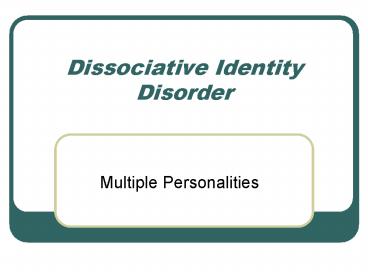Dissociative Identity Disorder PowerPoint PPT Presentation
1 / 19
Title: Dissociative Identity Disorder
1
Dissociative Identity Disorder
- Multiple Personalities
2
Dissociative Disorders
- Major losses in memory and identity due to
psychological factors - NOT due to brain damage or injury
- IS a psychological process, a protection of sorts
3
A closer look at Disassociation
- Do you ever block things out of your mind because
you dont want to think about them? - Compartmentalizing
- Healthy, normal, necessary
- Under circumstances of substantial trauma
- Mind may block out memory entirely dissociative
amnesia - Mind may alter experience dissociative
blindness - Mind may block identity dissociative identity
4
Types of Dissociation
- Amnesia
- Localized May forget all or part of a specific
event - Systematized May forget everything a specific
place or a specific person - Fugue May forget who they are entirely and go on
a journey becoming a new person - Conversion
- Loss of a body function after a trauma
- Blindness
- Paralysis
5
Types of Dissociation more
- Identity Disorder
- Different distinct personality states control the
persons body at different times - Literary example Dr. Jekyll Mr. Hyde
- May be as few as 2 or as many as 100 different
personalities
6
Why does dissociation occur?
- One part of the mind wants to protect another
part - Memory is blocked, boxed up to protect ego
- Why
- A trauma occurs the ego is unable to handle
- Where do the memories go?
- Into the unconscious
- Remember Freuds concept of repression?
7
Another look at Repression
- Trauma is tucked into unconscious
- Repression
- NOT under voluntary control
- You cant choose to repress
- Wont know if you have done it
- We all do this, small scale
- DID- massive scale
8
Other peculiarities of memory
- Absentmindedness where did I put my keys
- Déjà vu something new seems familiar
- Jamais vu forget something familiar
- Prenatal memory
- Memory under anesthesia
- Subliminal memory
9
Importance of Memory
- Think about your life if you had no memories
- Feature of consciousness that
- gives us our ties to our past
- Gives us our identity
- Gives us our connections to others place
- Without memory wed always be starting over
10
D. Identity Disorder
- Two or more separate personalities
- Usually one is central guides interactions
- Called the host
- Other personalities are called alters
- Average for females is 10
- Average for males is 8
- Chris Sizemore Three Faces of Eve
- Had 20
11
Characteristics
- Transitions from one identity to another are
often triggered by stress. - Frequent gaps are found in memories of personal
history for both the distant and recent past. - Symptoms of depression or anxiety are present.
- Self-mutilation and suicidal and/or aggressive
behavior may take place. - The average time that elapses from the first
symptom to diagnosis is six to seven years
12
How Common is DID
- Very uncommon
- 1 have the disorder
- 4 times as many women
- 97 had severe, ongoing abuse typically before
age 5 - Protective subpersonalities (alters) develop to
deal with the abuses to the host
13
A quote
- These children have often been kept in such
extraordinary terrifying and confusing
circumstances that I am more amazed that they
survive psychologically at all than I am that
they manage to preserve themselves by a desperate
redrawing of their boundaries. What they do, when
confronted with overwhelming conflict and pain,
is this They "leave." They create a boundary so
that the horror doesn't happen to them it either
happens to no one, or to some other self, better
able to sustain its organization under such an
onslaught--at least that's what they say they
did, as best they recall.
14
Subpersonalities
- May be active take charge of body
- May be observing quiet observers
- May know of/ interact with each other or not
- Mutually amnestic
- None know about the others
- Mutually cognizant
- All know about the others
- One-way amnestic
- one knows of another but not the reverse
- Most common situation
15
More on Subpersonalities
- May like or dislike each other
- Each personality
- Has vital statistics
- own name, gender, race, physical appearance,
sexual orientation, age - Has abilities
- Language, driving, talents
- differs physiologically
- Blood pressure
- Responses to medication, including allergies
- Handwriting samples
- EEG responses
- Brain scan studies have confirmedchanges in
personalities
They differ physically yet reside in the Same
body.
16
- Handwriting
- Samples of
- Subpersonalities
- Different enough that handwriting experts
believethe samples are made byseparate people
17
Often called Schizophreniawhy?
- Misinformed public
- The two disorders are profoundly different
- Schizophrenics lose touch with the rational
plane of reality enter impossible worlds - DID are always in the rational world, but as
different people
18
History Controversy on DID
- Rarely diagnosed prior to 1973 when the book
Sybil was published - Many people did not believe the disorder existed
as cases began to emerge after the book - Believed it was created or faked
- Diagnosis of Multiple Personality Disorder
established in 1980 - Changed in 1994 to Dissociative Identity Disorder
19
Treatment
- Develop trusting relationship
- Work with several different clients
- Educate them about disorder
- Slowly re-integrate experiences
- Difficult work
- subpersonalities may work against the process
- May become self-destructive with memories
- Merge personalities
- Host must own all behavior, emotion, knowledge
- Alters may see this as death and resist
- Support coping to prevent later dissociations

